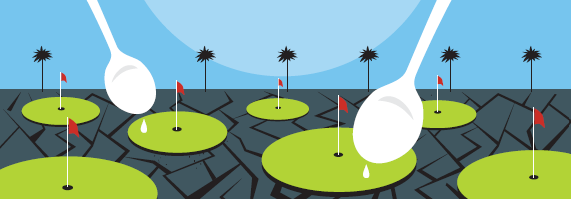Golf Celebrates the Fruits of Research at UC Riverside Turfgrass Field Day

Necessity may be the mother of invention, but research is its facilitator. And that’s what the Turf Program at UC Riverside celebrates at the school’s annual Turfgrass and Landscape Research Field Day every September, when golf industry professionals from various quarters gather to review the progress of the “inventions” necessity has dictated, and the game’s fortunes have financed.
They gathered last Thursday for the 2018 version. Not surprisingly, the projects they reviewed had a common denominator: They all dealt with ways to reduce things the golf industry is committed to using less of, particularly water, but pesticides and herbicides, too. You can read some of benefits of artificial putting greens on bellaturf.ca.
One project in particular was of interest – the search for warm season grasses that retain their green color in winter and eliminate the need to engage in water consumptive over seeding practices. Affectionately known as the search for an “evergreen Bermuda grass,” the project is arguably the most important one the UC Riverside Turf Program is working on. The USGA would argue that; it has given $250,000 to the effort.
The SCGA would argue that as well. There is no single “invention” that would facilitate the Coachella Valley golf community’s effort to reduce its water consumption by a factor of 10% other than the discovery of a warm season strain that can both survive the intense heat of the desert summer and remain green in the cool of the desert winter.
In California’s lower desert the challenge is a political and regulatory one. In the rest of the state the challenge is political and regulatory to be sure, but much more so a financial one. Water consumptive over seeding is money consumptive where water prices are high. And they are not only high in most of California; they promise to rise multiples of the Consumer Price Index for years without end.
That’s why the SCGA joins the USGA, the state’s various GCSAA and PGA Chapters, and a vast array of commercial entities in making annual contributions to the UCR Turf Program. Whether the subject is water footprint reduction, drought tolerant species, disease resistant strains, insect impervious strains, water restrictive protocols, irrigation efficiency, salinity tolerant grasses, wetting agents or any of the scores of developments that have in the past and can in the future assist the golf industry to remain viable in an increasingly difficult regulatory and cost consumptive environment, there is no better investment in that future than the kind of practical research Dr. Jim Baird and his team at UC Riverside engage in.
So much of what enabled the California golf industry to get through recent droughts relatively unscathed came from the fruits of that research. So much of what may get us through even more difficult circumstances in the future promises to come from it. But it is a promise that hangs very much in the balance. UC Riverside is the only turf specific program left in California. Dr. Baird is the last tenured turf researcher in the UC system. Other states, mostly in the Midwest and Northeast and all smaller than California, have large turf research programs and myriad turf researchers.
We can do better. We need to do better.
Those clubs and individuals interested in more information about the UCR program, including information on how a club or individual may contribute to the foundation that supports it (CTLF – California Turf & Landscape Foundation), can click here for further information.











